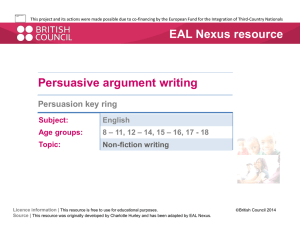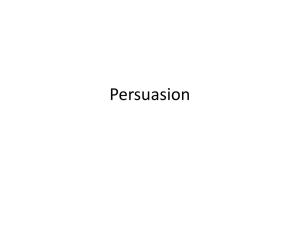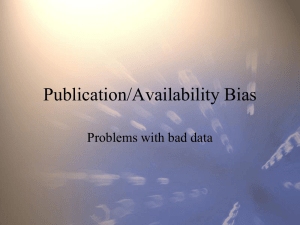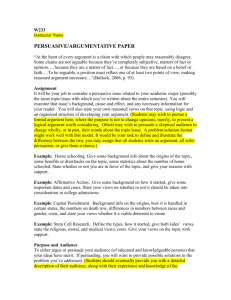The varying effects of hedge placement on argument strength
advertisement
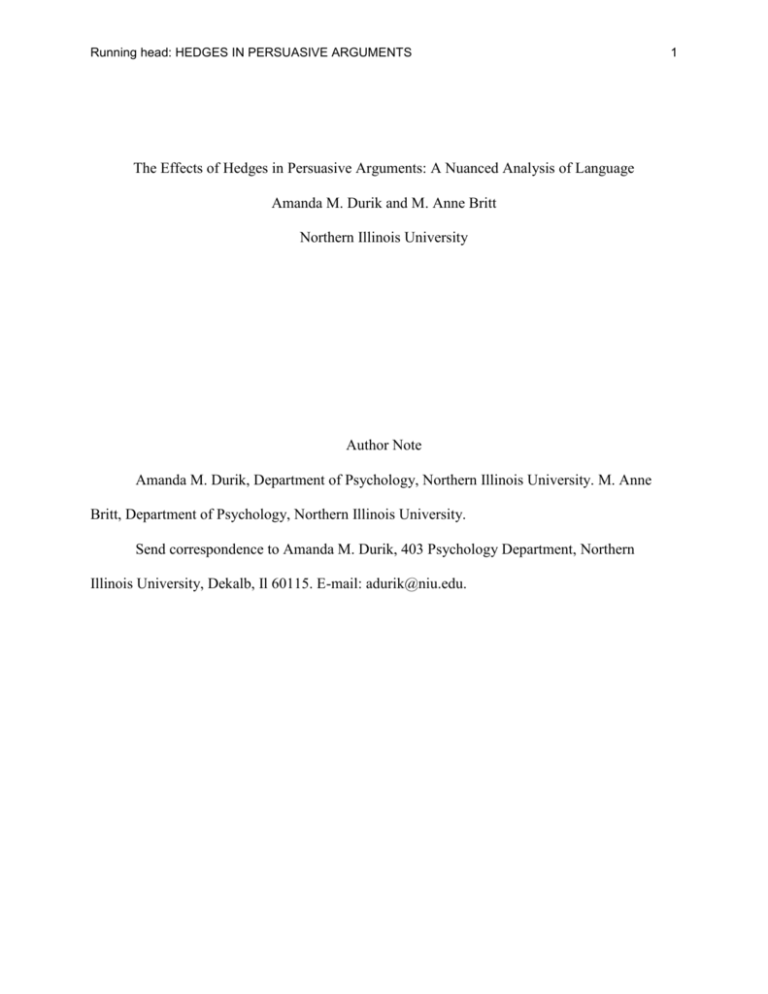
Running head: HEDGES IN PERSUASIVE ARGUMENTS The Effects of Hedges in Persuasive Arguments: A Nuanced Analysis of Language Amanda M. Durik and M. Anne Britt Northern Illinois University Author Note Amanda M. Durik, Department of Psychology, Northern Illinois University. M. Anne Britt, Department of Psychology, Northern Illinois University. Send correspondence to Amanda M. Durik, 403 Psychology Department, Northern Illinois University, Dekalb, Il 60115. E-mail: adurik@niu.edu. 1 Running head: HEDGES IN PERSUASIVE ARGUMENTS 2 Abstract Drawing together research on persuasion and text comprehension, two experiments tested the effects of hedge placement (Experiment 1) and hedge type (Experiment 2) on attitudes, source evaluations, and perceptions of argument strength. Participants read an editorial in support of implementing comprehensive exams at their university. Experiment 1 showed that hedges placed on data statements (and not interpretation statements) led to negative perceptions of the policy, source, and argument. This was especially pronounced on source evaluations among individuals with more scientific training. Experiment 2 revealed that colloquial, but not professional, hedges placed on interpretation statements led to more negative evaluations relative to no hedges. Data related to perceptions of the source were moderated by individual differences in scientific reasoning. This research suggests that hedges describing data statements and/or that use colloquial language can, but do not always, undermine persuasive attempts. Keywords: persuasion, attitudes, hedges, qualifiers Running head: HEDGES IN PERSUASIVE ARGUMENTS 3 The Effects of Hedges in Persuasive Arguments: A Nuanced Analysis of Language Many variables can affect the extent to which a persuasive communication changes attitudes and guides perceptions of the message and the source of the message (Hovland, Janis, & Kelly, 1953). Petty and Cacioppo (1986) proposed a model of how persuasion occurs as a result of aspects of the message itself (e.g., argument strength, number of arguments) or as a result of aspects of the way the message is presented (e.g., source likability or authority; see review by Chaiken, Liberman, & Eagly, 1989). Moreover, depending on how a persuasive communication is composed and conveyed, certain aspects of communications are more demanding of cognitive resources than others. Research has shown that individuals will be more affected by resource-demanding aspects of a persuasive communication if the individual is both motivated and able to attend to those aspects of the communication (Chaiken, 1980; Cacioppo, Petty, Kao, & Rodriguez, 1986; Kruglanski & Thompsom, 1999; Leippe & Elkin, 1987; Petty, Cacioppo, & Goldman, 1981). In prior research showing the deleterious effects of hedges on argument strength (Blankenship & Holtgraves, 2005), hedges typically accompanied statements of research results rather than statements of interpretations of results. This experiment tested whether the placement of hedges or the mere presence of hedges determines when hedges undermine persuasive attempts. Specifically, we hypothesized that hedges used to temper statements about data would undermine argument effectiveness but that hedges used to temper statements about interpretations would not undermine argument effectiveness. Method Participants Running head: HEDGES IN PERSUASIVE ARGUMENTS 4 The participants in this study were 150 students (46% male, excluding two individuals who did not report their gender) from a Midwestern university. The students were drawn from two undergraduate courses and participated in the study in exchange for course credit. Forty percent of the sample was drawn from an introductory psychology course and the remaining 60% was from a research methods course. The research methods course was also taught in the psychology department and is taken primarily by students in their junior year of college. Materials Participants read and responded to one of three versions of an editorial offering support for the implementation of final exams. The editorial was the same as that used by Blankenship and Holtgraves (2005) except that the name of the University where the policy would be implemented was changed to be the school the participants attended. All versions of the editorial contained strong arguments for why final exams should be implemented at the university (e.g., improve learning, expand employment opportunities). Design This experiment was a one-way, three-cell design. Participants were randomly assigned to one of three editorial conditions (no-hedge, data hedge, or interpretation hedge). The dependent variables included attitudes about the policy, perceptions of the source, and evaluations of the argument strength. Procedure Participants read the assigned editorial and returned it to the experimenter before receiving the evaluation questionnaire. Participants were instructed to read the editorial carefully and then to respond to the items on the questionnaire. Results Running head: HEDGES IN PERSUASIVE ARGUMENTS 5 We conducted a one-way ANOVA to evaluate the extent to which editorial condition affected perceptions of the source of the editorial. This analysis yielded a significant effect, F(2, 147) = 6.57, p < .01. Consistent with our hypotheses, the source of the argument was evaluated less positively in the data hedge condition (M = 4.00, SD = 1.13) than in either the control (M = 4.72, SD = 0.94) or interpretation (M = 4.55, SD = 1.05) conditions. The control and interpretation conditions did not differ from each other. Finally, there was also a significant effect of editorial condition on argument quality ratings, F(2, 147) = 8.57, p < .01. Again, post-hoc tests indicated that the argument was perceived as being lower quality by participants in the data condition (M = 3.87, SD = 1.40) than in either the control (M = 4.85, SD = 1.19) or interpretation (M = 4.74, SD = 1.29) conditions, which were not reliably different. Discussion These results replicate Blankenship and Holtgraves’s (2005) findings that the source of a message marked with hedges primarily on data statements was viewed more negatively and the message itself was viewed as less persuasive and weaker compared to an unhedged message. As predicted, data-hedged statements were also viewed more negatively than interpretative-hedged statements, which were not viewed negatively relative to an unhedged message. Overall, these data lend consistent support for the idea that it is not solely the presence of hedges that undermines the effects of a persuasive message, but instead the particular placement of hedges in relation to statements of research results. These data suggest that a more finegrained analysis is warranted when examining the specific aspects of a persuasive message. Running head: HEDGES IN PERSUASIVE ARGUMENTS 6 References Blankenship, K. L., & Holtgraves, T. (2005). The role of different markers of linguistic powerlessness in persuasion. Journal of Language and Social Psychology, 24(1), 3-24. Cacioppo, J. T., Petty, R. E., Kao, C. F., & Rodriguez, R. (1986). Central and peripheral routes to persuasion An Individual Difference Perspective. Journal of Personality and Social Psychology, 51(5), 1032-1043. Chaiken, S. (1980). Heuristic versus systematic information processing and the use of source versus message cues in persuasion. Journal of Personality and Social Psychology, 39, 752-756. Chaiken, S., Liberman, A., & Eagly, A. H. (1989). Heuristic and systematic processing within and beyond the persuasion context. In J. S. Uleman & J. A. Bargh (Eds.), Unintended thought (pp. 212–252). New York: Guilford Press. Hovland, C. I., Janis, I. L., & Kelly, H. H. (1953). Communication and persuasion. New Haven, CT: Yale University Press. Kruglanski, A. W., & Thompson, E. P. (1999). Persuasion by a single route: A view from the unimodel. Psychological Inquiry, 10, 83-109. Leippe, M. R., & Elkin, R. A. (1987). When motives clash: Issue involvement and response involvement as determinants of persuasion. Journal of Personality and Social Psychology, 52, 269-278. Petty, R. E., & Cacioppo, J. T. (1986). Communication and persuasion: Central and peripheral routes to attitude change. New York: Springer-Verlag. Petty, R. E., Cacioppo, J. T., & Goldman, R. (1981). Personal involvement as a determinant of argument based persuasion. Journal of Personality and Social Psychology, 41, 847-855.

